JAIPUR - SHEER SYMPHONY IN PINK
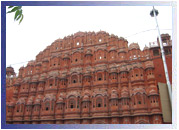
The
picturesque capital of Rajasthan, Jaipur the fantasy in Pink sand stone and
clour washed pink - the colour associated with hospitality in Rajput culture.
One of the finest planned cities of India. Not long after ascending the throne,
Maharaja Jai Singh II (1699 - 1744) felt need to shift his seat of administration
from Amber to new site and so laid out the foundation of Jaipur city in 1727.
Jai Singh was not only a great ruler but also a renowned mathematician and
astrologer, his various talents are clearly exhibited in the city. Vidhydhar
Bhattacharya designed Jaipur as per the Hindu treatise, Shilp Shastra. The
city was laid with great precision, it could also be called as the first planned
city of the country. The roads were quite wide and intersected at right angles,
the entire city being divided into rectangular blocks and surrounded by a
peripheral wall with huge gates guarding it. The market places were named
after the commodity, which was supposed to be predominantly sold or manufactured
there.
Jaipur displays remarkable harmony and architectural splendor. The ancient
heart of the pink city still beats inits fairt tale Palaces, rugged Fortresses
perched on barren hill and board avenues that dot the entire city. The only
planned city of its time, Jaipur is encircled by formidable wall. it is also
a home of excellent handicrafts especially known for the exquisite gold jewellery
enamelled or inlaid with precious and semi precious stones, blue pottery,
carving on wood, stone & ivory, block print, tie & dye textiles, hand
made paper, miniature painting etc.
Palaces to visit
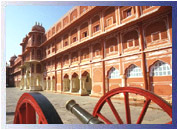 CITY
PALACE AND S.M.S. II MUSEUM -
CITY
PALACE AND S.M.S. II MUSEUM - situated in the heart of the old CitY is
the former royal residence. it occupies about one seventh of the old city
area. The palace is a blend of Rajput and Mughal architecture, it houses a
Seven storeyed Chandra Mahal in the centre, which affords a fine view of the
gardens and the city. DIWAN-E-AM (Hall of public audience) has intricate decorations
and collection of manuscripts, DIWAN-E-KHAS (Hall of private audience) has
a marble pawed gallery Mubarak Mahal has a rich collection of costumes and
textiles. There is a Clock Tower near Mubarak Mahal. Sileh Khana has a collection
of armory and weapons.
HAWA MAHAL - Hawa Mahal or Palace of winds is major Rajput landmark, built
in 1799, by Maharaja Sawai Pratap Singh, is the most recognizable monument
of Jaipur. The 5 storeyed stunning semi-octagonal monument having 152 windows
with over hanging latticed balconies is a fine piece of Rajput architecture.
Originally designed for the royal ladies to watch and enjoy the processions
and other activities, on the street below. Now it houses a well laid out museum.
The display “Jaipur past and present” is the special feature of
this newly setup museum.
JANTAR MANTAR (Observatory) - A stone Observatory built in 18th century
by Maharaja Sawai Jai
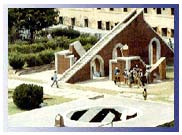
Singh
II, the huge masonary instruments were used to study the movement of constellations
and stars in the sky. Enormous sun-dial still provide accurate time, which
are subject to daily corrections.
JALMAHAL - (6 kms) on the way to Amer, this small palace is set in
the middle of Man Sagar Lake. A paved causeway leads upto the beautiful water
palace.
GAITOR - (6 kms) At the foot hill of Nahargarh stands the memorials
to the former rulers of Jaipur the place has some gracefully carved cenotaphs
in white marble.
JAIGARH FORT - (15 kms.) One of the few military structures of medieval
India. Standing on a hilltop, overlooking the palaces and city of Amer. The
world’s biggest cannon on wheels- the Jai Ban is positioned here, built
during reign of Maharaja Sawai Jaisingh. It has a twenty feet long barrel
and pumped in the cannon for a single shot.
NAHARGARH FORT - (15 kms.) A sentinel to the pink city is Nahargah
Fort, situated beyond the hills of Jaigarh and cresting a hill about 600 ft.
above the city, the fort was built in 1734. The walls of the fort run along
the ridge and within are architectural beauties like Hawa Mandir and Madhvendra
Bhawan.
GALTA - (10 kms.) This holy pilgrimage centre has a temple dedicated
to the Sun God (Which is the
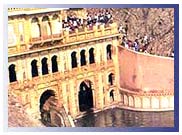
only
one of its kind in this part of the country) and natural spring. It crests
the ridge over a picturesque gorge and provides an impressive view of the
city. As the legend goes, sage Galav performed a difficult penance here.
ISHWAR LAT - ‘Swarg Suli’ or ‘heaven piercing minaret’,
the tower, near Tripolia gate, built by Maharaja Ishwari Singh (1744-51).
It offers one of the most breathtaking view of the city.
CENTRAL MUSEUM - situated in the Ram Niwas Garden. This graceful building
was founded in 1876 by Prince Albert (also known as Albert Hall). It has a
rare collection of archaeological and handicraft pieces.
DOLLS MUSEUM - a collection of beautiful dolls from all over the world,
it is situated on Jawahar Lal Nehru Marg.
BIRLA PLANETARIUM - It offers unique audio-visual education about stars
and entertainment with its modern computerised projection system.
R. C. MUSEUM OF INDOLOGY - It has a large collection of historical
archaeological manuscripts, miniature paintings and other artifacts. Timing
10.00 to 16.00 hrs, Phone: 2607455
MOTIDOONGARI - perched on a hill top on the southern horizon. It is
a replica of a Scottish castle.
LAXMI NARAYAN TEMPLE - is situated just below the Moti 000ngri, known
for the intricate marble carvings in white marble, popularly known as Birla
Temple.
MAHARANI KICHHATRI - The funeral place for the royal ladies, marked
by some wonderfully carved cenotaphs.
SISODIA RANI GRADEN - (5 kms.) on the road to Agra, the magnificent
palace garden was built by Maharaja Sawai Jai Singh II in 1710 for his queen.
VIDHYADHAR GARDEN - (5 kms.) on the way to Agra, built by Viyadhar,
the chief architect and town planner of
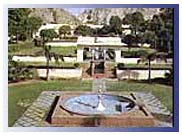
Jaipur. This beautiful terraced garden has several galleries and pavilions
decorated with exquisite murals, depicting Lord Krishna.
KANAK VRINDAVAN - (6.5 Kms on the way to Amer) This newly restored
temple and garden, near Jal Mahal, has beautiful gardens and is popular picnic
place. This is also beautiful location for film shooting.
AMBER - The old capital of the Kachhwahas stands atop a range of craggy
hills. The fort is remarkable as much for the majestic grandeur of its surroundings
as for its sturdy battlements and beautiful palaces. It is a fine blend of
Hindu and Muslim architecture. The solemn dignity of it red sandstone and
white marble pavilions, when reflected in the lake at the foot hill, is a
sight to behold. The original palace was built by Raja Man Singh, the additional
extensions were built by Maharaja Mirja Raja Jai Singh and Sawai Jai Singh
lIthe last Maharaja of Amer, who built a new city called Jaipur, where he
shfted his capital in 1727.
The palace complex is lavishly ornamented and displays the riches of Amer.
Sheesh Mahal chamber of Mirrors. Diwan-e-Am or the Hall of Public Audience
is a beautifully proportioned hall open on three sides and stands on two rows
of ornamented pillars. Diwan e-Khas or the Hall of Private Audience has delicate
mosaic work in glass. Sukh mandir is guarded by sandalwood doors inlaid with
ivory. Throughout the massive fort finely carved lattice windows, exquisitely
painted doorways, halls and finely sculptured pillars crave for attention.
The old city of Amer was the seat of power and bustling with life and prosperity.
Other worth seeing sites are Jagat Shiromani Temple, Narsinghji temple, the
stepwell of Panna Meena and fine carved royal cenotaphs on the road to Delhi.
EXCURSIONS 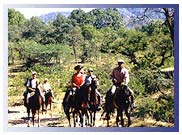 SAMODE -
SAMODE - 40 Km to the northwest is the popular small village Samode
the royal residence of the prime minister of Jaipur. Nestling beneath a hill
fort Samode with its fairytale Palace that has some of the most exquisite
mirrior work and fresoes. The Durbar hall at Samode Palace is one of the most
beautifully painted chambers in Rajasthan. Close by is the Samode Bagh, the
garden pavelion with charming water channels and ancient trees.
SAMBHAR - Famous for the country’s largest inland salt lake, is
an ancient city. It was the first capital of the Chauhan dynasty. Sakambhari,
as it was founded near the temple of Goddess Sakambhari, famous for its holy
Devyani tank, the palace and the nearby Naliasar: where the 3rd century onwards
sculptures and terracottas were found in excavation. This place is situated
on the Sambhar-Naraina Road.
VIRATNAGAR - 86 K.m. on the Shahpura-Alwar road, The site of ancient
Viratnagar is of great antiquity. It contains the relics and structures of
Mauryan, Mugal and Rajput periods.
RAMGARH LAKE - (28 Kms) the huge artificial lake, a popular picnic
spot. The ruins of the old fort and the temple of Jamwa Mata indicate that
it was the seat of power of the Kachhawahas before they moved to Amer.
SAMODE - (40 kms) a quaint village amidst the hills, the Samode palace
set in fairy tale surrounding, has beautiful wall paintings & mirror works,
now this is a heritage hotel.
BAGRU - (35 Kms.) the village on the Ajmer road, is known for its hand
block printing, the characteristic prints are called as Bagru prints. The
fort here is still in a good condition.
SANGANER - (16 Kms.) another centre of hand block printed textile and
hand made paper. It also has historical ruins and Jam temples.
FAIRS AND FESTIVALS
The Pink City rejoices and celebrates the fairs and festivals with pomp and
gaiety since time immemorial. These fairs and festivals reflect the rich culture
and heritage of the region. Jaipur has a flair for celebrating every occasion.
ELEPHANT FESTIVAL - 14 March, 2006, the elephant enthrall the spectators
on the day of the Colourful festival of

Holi at Chaugan stadium. Beautifully decorated elephants assemble for royal
procession, Elephant polo match, races etc. & Rajasthan Folk music &
dance performances are part of the festival.
GANGAUR - 1-2 April, 2006, this festival is celebrated by the maidens
and married women, and is dedicated to Gauri, the incarnation of Goddess Parvati,
the consort of Lord Shiva. A Colourful procession is taken out from Zanana
Deodhi of the City Palace, passing through Tripolia Bazar, Gangauri Bazar,
Chaugan and converging near Talkatora for two consecutive days.
TEEJ - 28-29 July, 2006, festival marking the advent of monsoon, swings
are hung from trees and decorated with flowers. Young girls sing songs of
love and about the rain. The festival is dedicated to parvati, commemorating
the day when she was united with Lord Shiva, A magnificent procession is taken
out from City Palace, similar to the Gangaur procession, for two consecutive
days.
MAKAR SANKRANTI - celebrated on the 14th of January, every year with
traditional fervour, the devotees take a holy dip in the holy tank at Galtaji,
it has now also become a kite flying festival, millions of colourful kites
come on the sky of Jaipur on this day.
SHITLA ASHTAMI - (March-April) this festival is locally called as Basoda,
is celebrated to ward off the dreaded disease of small pox. The most famous
fair is held at the Shitla Mata temple in Chaksu (on the Jaipur Kota Road),
people gather here to pray and celebrate.
DONKEY FAIR - (Khalkani Mata Mela) (October) the donkeys day at Looniyawas
near Sanganer, Thousands of donkeys from all over north India are brought
here for buying and selling. The donkey races and sports are organised for
the merriment of people. A rare sight indeed.
::
Click
here for Reservation
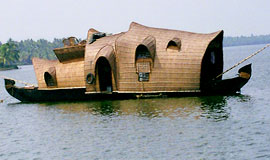
 The
picturesque capital of Rajasthan, Jaipur the fantasy in Pink sand stone and
clour washed pink - the colour associated with hospitality in Rajput culture.
One of the finest planned cities of India. Not long after ascending the throne,
Maharaja Jai Singh II (1699 - 1744) felt need to shift his seat of administration
from Amber to new site and so laid out the foundation of Jaipur city in 1727.
Jai Singh was not only a great ruler but also a renowned mathematician and
astrologer, his various talents are clearly exhibited in the city. Vidhydhar
Bhattacharya designed Jaipur as per the Hindu treatise, Shilp Shastra. The
city was laid with great precision, it could also be called as the first planned
city of the country. The roads were quite wide and intersected at right angles,
the entire city being divided into rectangular blocks and surrounded by a
peripheral wall with huge gates guarding it. The market places were named
after the commodity, which was supposed to be predominantly sold or manufactured
there.
The
picturesque capital of Rajasthan, Jaipur the fantasy in Pink sand stone and
clour washed pink - the colour associated with hospitality in Rajput culture.
One of the finest planned cities of India. Not long after ascending the throne,
Maharaja Jai Singh II (1699 - 1744) felt need to shift his seat of administration
from Amber to new site and so laid out the foundation of Jaipur city in 1727.
Jai Singh was not only a great ruler but also a renowned mathematician and
astrologer, his various talents are clearly exhibited in the city. Vidhydhar
Bhattacharya designed Jaipur as per the Hindu treatise, Shilp Shastra. The
city was laid with great precision, it could also be called as the first planned
city of the country. The roads were quite wide and intersected at right angles,
the entire city being divided into rectangular blocks and surrounded by a
peripheral wall with huge gates guarding it. The market places were named
after the commodity, which was supposed to be predominantly sold or manufactured
there.  CITY
PALACE AND S.M.S. II MUSEUM - situated in the heart of the old CitY is
the former royal residence. it occupies about one seventh of the old city
area. The palace is a blend of Rajput and Mughal architecture, it houses a
Seven storeyed Chandra Mahal in the centre, which affords a fine view of the
gardens and the city. DIWAN-E-AM (Hall of public audience) has intricate decorations
and collection of manuscripts, DIWAN-E-KHAS (Hall of private audience) has
a marble pawed gallery Mubarak Mahal has a rich collection of costumes and
textiles. There is a Clock Tower near Mubarak Mahal. Sileh Khana has a collection
of armory and weapons.
CITY
PALACE AND S.M.S. II MUSEUM - situated in the heart of the old CitY is
the former royal residence. it occupies about one seventh of the old city
area. The palace is a blend of Rajput and Mughal architecture, it houses a
Seven storeyed Chandra Mahal in the centre, which affords a fine view of the
gardens and the city. DIWAN-E-AM (Hall of public audience) has intricate decorations
and collection of manuscripts, DIWAN-E-KHAS (Hall of private audience) has
a marble pawed gallery Mubarak Mahal has a rich collection of costumes and
textiles. There is a Clock Tower near Mubarak Mahal. Sileh Khana has a collection
of armory and weapons.  Singh
II, the huge masonary instruments were used to study the movement of constellations
and stars in the sky. Enormous sun-dial still provide accurate time, which
are subject to daily corrections.
Singh
II, the huge masonary instruments were used to study the movement of constellations
and stars in the sky. Enormous sun-dial still provide accurate time, which
are subject to daily corrections.  only
one of its kind in this part of the country) and natural spring. It crests
the ridge over a picturesque gorge and provides an impressive view of the
city. As the legend goes, sage Galav performed a difficult penance here.
only
one of its kind in this part of the country) and natural spring. It crests
the ridge over a picturesque gorge and provides an impressive view of the
city. As the legend goes, sage Galav performed a difficult penance here.  Jaipur. This beautiful terraced garden has several galleries and pavilions
decorated with exquisite murals, depicting Lord Krishna.
Jaipur. This beautiful terraced garden has several galleries and pavilions
decorated with exquisite murals, depicting Lord Krishna. 
 Holi at Chaugan stadium. Beautifully decorated elephants assemble for royal
procession, Elephant polo match, races etc. & Rajasthan Folk music &
dance performances are part of the festival.
Holi at Chaugan stadium. Beautifully decorated elephants assemble for royal
procession, Elephant polo match, races etc. & Rajasthan Folk music &
dance performances are part of the festival.